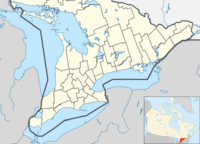Mississaugas of the Credit First Nation facts for kids
Quick facts for kids
Mississaugas of the Credit First Nation
Mazina'iga-ziibing Misi-zaagiwininiwag
|
|
|---|---|
| New Credit Indian Reserve No. 40A | |
| Country | Canada |
| Province | Ontario |
| County | Brant |
| First Nation | Mississaugas of the Credit |
| Area
(2021)
|
|
| • Land | 25.18 km2 (9.72 sq mi) |
| Population
(2021)
|
|
| • Total | 775 |
| • Density | 30.8/km2 (80/sq mi) |
| Website | mncfn.ca |
The Mississaugas of the Credit First Nation is a group of First Nations people. They are part of the Mississaugas, who are a sub-group of the larger Ojibwe people. Their traditional language, Ojibwe, calls them Mazina'iga-ziibing Misi-zaagiwininiwag, which means "Mississauga people at the Credit River."
This First Nation is located in south-central Ontario, Canada. Their main community is near Brantford. In April 2015, about 2,330 people were members of the Mississaugas of the Credit First Nation. Around 850 of these members lived on their reserve. The reserve is called New Credit 40A Indian Reserve and covers about 2,392.6 hectares. It is located near Hagersville, Ontario, right next to the Six Nations of the Grand River reserve.
Contents
History of the Mississaugas of the Credit Land
In the 1800s, many European settlers moved into the area. The Mississaugas felt pressure to move from their reserve. This reserve was located in what is now the city of Mississauga.
Moving to New Credit
The Mississaugas could not agree with the government of the time. So, in 1848, the Six Nations Confederacy offered them land. This land was 4,800 acres within the Six Nations' own property. It was given to the Mississaugas as a thank you. The Mississaugas had allowed the British to buy land in 1784. This land was used to create the Six Nations Reserve.
The Haldimand Proclamation
The Six Nations Reserve was given to the Six Nations by the Haldimand Proclamation. This was a way to thank them for helping the British during the American Revolutionary War. It allowed them to move from their old homes in what became New York State. The Six Nations Reserve is special because it has a smaller reserve inside it for another First Nation.
Purchasing Their Own Land
Later, the Mississaugas bought the land that had been gifted to them. They also bought an extra 1,200 acres. They paid $10,000.00 for this on June 15, 1903. This payment gave them the right to use and live on the land forever without being disturbed.
Current Reserve Location
Today, the reserve includes specific land lots in the Township of Tuscarora in County of Brant. It also includes lots in the Township of Oneida. In 1997, the Mississaugas of the Credit First Nation bought another 59 acres. This land is next to Ontario Highway 6 near Hagersville.
Toronto Land Claim Settlement
The First Nation made a claim for land where the city of Toronto now stands. This claim was about the Toronto Purchase of 1787, which was a disputed agreement.
The 2010 Agreement
In 2010, the Canadian government agreed to pay the First Nation $145 million. This amount was based on the historical value of the land, updated to today's money. The money was given to the First Nation's government. Each of the 1,700 members at that time received $20,000. The rest of the money was put into a special fund for future generations. For a short time, the First Nation paused new memberships. This was done to make sure the largest possible amount of money went to the members who were already registered.
Name Change
On January 8, 2019, the Mississaugas of the New Credit announced a name change. They are now officially known as The Mississaugas of the Credit.
Prominent Members
- Harry LaForme – He was a judge in an appeals court. He also led the Truth and Reconciliation Commission of Canada.
- Walt Secord – An Australian politician.
- Wabakinine – A Mississauga Chief and warrior. He died in 1796 while protecting his sister.
- Peter Jones (Kahkewāquonāby) – A Chief and a Methodist minister.


